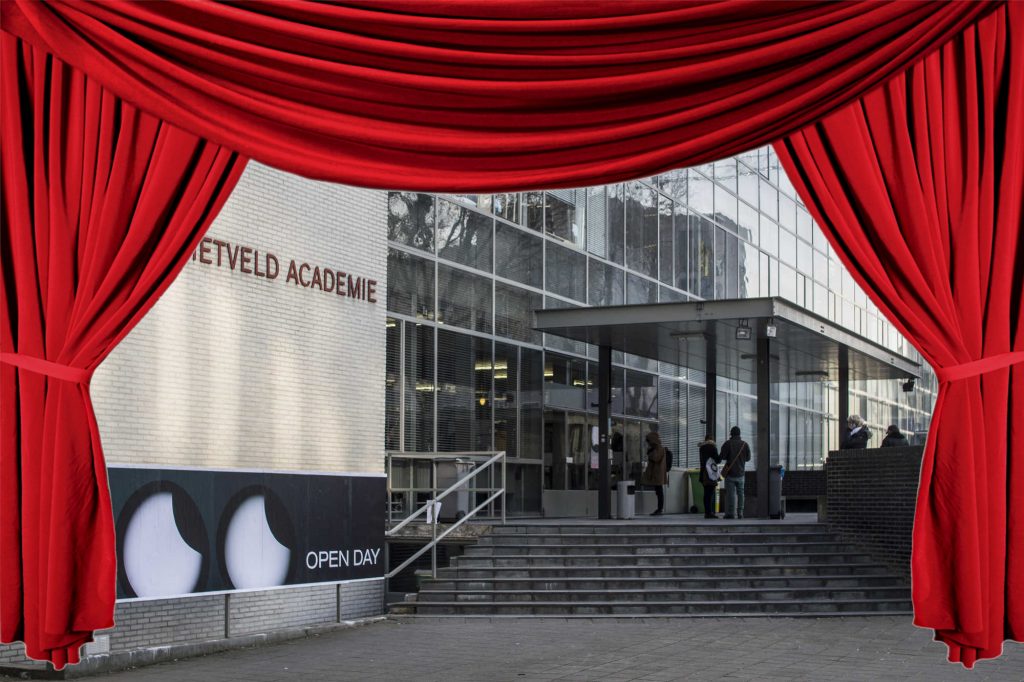
The ultimate goal of all art is the spectacle! The ancient drama was once the main purpose of the visual arts, and it was institutionalized as an indispensable part of life. Today, it exists in complacent isolation, from which it can only be salvaged by the purposeful and cooperative endeavors of all artists. Architects, painters and sculptors, designers, writers and potters must learn a new way of seeing and understanding the composite character of the theater, both as a totality and in terms of its parts. Their work will then re-imbue itself with the spirit of the spectacle, which it lost being caged in a white cube.
The art schools of old were incapable of producing this unity—and how could they, for art may not be taught. They must return to the performative, to the spectacle, the theater. They must get back up on the stage. This world of mere conceptual products must at long last become a world of performers. When a young person who senses within them-self a love for creative endeavor begins their career, the context of the theater will give them unrestrained freedom to achieve excellence in their practice of art, as well on stage as behind the scenes.
Architects, sculptors, painters, photographers, weavers and dressmakers—we all must return to the collective spectacle! For there is no such thing as “art by profession”. There is no essential difference between an artist and an actor. The artist is an exalted performer. Merciful heaven, in rare moments of illumination beyond man’s will, may allow art to blossom from the work of his hand, but the foundations of proficiency are indispensable to every artist. This is the original source of creative design.
So let us therefore create a new ensemble of actors, free of the divisive class pretensions that endeavored to raise a prideful barrier between actors and artists! Let us strive for, conceive and create the new theater of the future that will unite every discipline, architecture and sculpture and painting, video and glassblowing and jewellery which will one day rise heavenwards from the million hands of artists as a clear symbol of a new spectacle to come.
If you know your Bauhaus well, you may recognize this text as it is a rewritten version of the Bauhaus Manifesto. When Walter Gropius wrote the original manifesto back in April 1919 he wanted to unify ”architects, painters and sculptors” by going back to the crafts and combine it with fine arts. When I’m rewriting it now, to the month exactly 100 years later, I’m also aiming to unify not only architects, painters and sculptors, but all artistic disciplines, through a revival of, and return to, the performative arts within the Gerrit Rietveld Academie.
We are always told to get out of our comfort zone, to aim for the impossible, the fantastic, to let us be carried away and explore our dreams. Where else better to do all that than in the context of the theater? It has room for, and it needs, everybody’s interests and practices! Apart from performers it needs just as many writers, sculptors, painters, musicians, designers, costume makers – you name it. Furthermore, there is nothing you can’t do on stage; if you want to fly, then you fly! This limitless space of imagination and exploration is something that should be available and encouraged for everyone, performer or not. With calling it ”theater” rather than ”performative arts” we can also emphasize on this collaboration and intertwining of knowledge and different practices which is absolutely essential.
”But you can already do this, you can do (almost) all you want at the academy!” some might say, and while that sure is true, the space and importance given to performative arts in this school is very limited compared to it’s precursor. Yes, there is a small group of teachers and students engaged with it within the academy (basically restricted to the Fine arts and VAV departments), and yes there used to be a theater department back in the days. But why isn’t it a natural part of the education for all of us, and not only for students in a certain department?
Reading Human – space – machine: stage experiments at the Bauhaus by Torsten Blume and Christian Hiller (Spector, Leipzig, 2014) it becomes clear that movement classes of different sorts were an important part of the Bauhaus’ Vorlehre – the equivalent of the Rietveld’s Basisjaar. During Johannes Itten’s years the focus was a “therapeutically motivated balance of body and soul” while later on, under Lászlo Moholy-Nagy’s and Josef Albers’ board, the physical exercise became more “businesslike and functional”. No matter the purpose, in both of the above mentioned cases the physical movement of the body was natural elements of the teaching that we are now missing but that could easily be brought back to life in the form of performative arts.
I say:
Let’s have theater class once a week in Basic Year!
Let’s build a proper stage with opportunities to experiment with light, sound, scenography and spatial design!
Let’s all and everyone, from our different practices and fields of interests, unite and collaborate in this machinery that is the Theater!
In the spirit of Oskar Schlemmer, I wish for us a rich and alive theater as the most central and unifying element of the Gerrit Rietveld Academie.
Let’s make a spectacle!